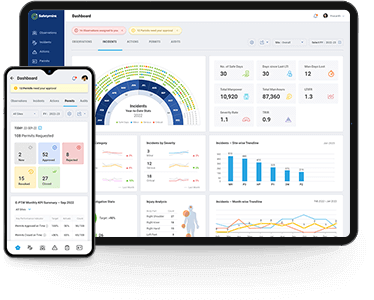
The 6 stages of Incident Investigation
Incident investigation is the meticulous process of uncovering the what, why, and how behind workplace mishaps. It’s a vital compass for organizations, helping them navigate toward safer, more resilient operations. These six steps serve as your trusted roadmap, ensuring that every incident is not just a problem solved but a lesson learned. Let’s explore why mastering this process is paramount in the pursuit of a secure and productive future.
Here’s the list of the 6 Key Stages of Incident Investigation:
1. Immediate response to the incident
2. Gathering and preserving evidence
3. Identifying root causes
4. Developing corrective and preventive actions (CAPA)
5. Reporting and documentation
6. Reviewing and closing the investigation
Now, let’s delve deeper on each of these stages.
1. Immediate response to the incident:
In the chaotic aftermath of an incident, every second counts. The first stage, immediate response, is like the front lines of a battle. It’s about swift action and cool heads.

Stay Calm: First and foremost, stay calm. Panic only adds to the chaos. Take a deep breath.
Secure the Scene: Ensure everyone’s safety. If it’s a hazardous situation, evacuate and secure the area.
Alert Authorities: Dial emergency services. Get professional help on the way.
First Aid: Administer first aid if needed, but remember your own safety too.
Preserve Evidence: If it’s safe, start preserving evidence that could help in later stages.
The initial response sets the tone for the entire investigation. Be swift, stay safe, and focus on what’s crucial.
See how Safetymint can help in managing incidents
2. Gathering and Preserving Evidence:
After the storm comes the search for clues. In this phase, evidence is gold.
Document: Take photos, notes, and record witness accounts. Every detail matters.
Secure Evidence: Keep it safe from tampering or contamination. Lock it up if you can.
Chain of Custody: Maintain a clear record of who touched what, when.
Expertise: Involve experts if necessary – they know how to handle delicate evidence.
Don’t Rush: Haste can taint evidence. Slow and steady wins the race.
Remember, evidence is the heart of your investigation. Handle it with care, like a priceless gem.

3. Identifying Root Causes:
Now, it’s time to dig deep. Find the “why” behind the “what.”
Ask Questions: Investigate thoroughly. Don’t stop at the surface; peel back the layers.
Root Cause Analysis: Use techniques like the “5 Whys” to uncover the core issues.
Patterns: Look for recurring problems. Sometimes, it’s not a one-off incident.
Data is Key: Analyze data, charts, and trends. They hold valuable clues.
Team Effort: Collaborate with experts and team members. Fresh perspectives can be enlightening.
In this phase, curiosity is your best friend. Keep asking questions until you strike gold – the root cause.
4. Developing Corrective and Preventive Actions (CAPA):
Time for action! This stage is all about fixing the problem and preventing a repeat.
Prioritize: Identify which issues need immediate attention. Not all problems are equal.
Action Plan: Create a clear roadmap for what needs to change.
Responsibility: Assign roles to ensure accountability. Who does what by when?
Feedback Loop: Regularly review progress and adapt as needed. Flexibility is key.
Continuous Improvement: CAPA is not a one-time fix; it’s an ongoing commitment to betterment.
Now, roll up those sleeves and get to work – the solutions are within reach.

5. Reporting and Documentation:
You’ve got the answers; now, it’s time to share them effectively.
Clear Report: Present findings concisely and logically. No jargon, just clarity.
Recommendations: Offer actionable solutions, not just problems.
Transparency: Share the report with relevant parties. Honesty builds trust.
Legal Obligations: Ensure compliance with regulations in your reporting.
Archiving: Safeguard all records for future reference. You never know when you’ll need them.
A well-crafted report is your legacy, guiding future actions and decisions.
6. Reviewing and Closing the Investigation:
The final stretch – let’s wrap it up and learn from the journey.
Objective Review: Evaluate the entire process. What went well? What could be better?
Lessons Learned: Extract wisdom from mistakes and successes.
Closure: Officially close the investigation, documenting the end.
Share Insights: Share findings with the organization. Knowledge is power.
Feedback Loop Again: Ensure the changes made are effective, and adjust if necessary.
Closing an investigation is not the end but a new beginning with a safer and smarter path ahead.
Incident investigation – made easier with Safetymint

With the Safetymint Incident and Observation management system, reporting incidents, near-misses and observations are a breeze. Your employees can use the Safetymint mobile app or the web browser to report and also attach pictures and documents to the submissions. Each incident can go through a 5-step incident investigation process where root causes can be analyzed and corrective actions assigned. With the Actions feature, you can ensure that all actions assigned are closed on time. Additionally, the software also comes with extensive analytic data through the dashboard.
Get started with a 14-day free trial.

Ramesh Nair is the Founder and Principal Partner of Niyati Technologies, the company behind Safetymint.
He’s a dedicated advocate for workplace safety. Ramesh firmly believes that every individual deserves to return home safely after a day’s work. Safetymint, the innovative safety management software, emerged from this conviction. It’s a platform designed to streamline safety management, empower safety professionals, and enhance safety in workplaces.
Through his blog, Ramesh shares insights, best practices, and innovative solutions for workplace safety. Visit his social media profiles to follow him for regular updates.



